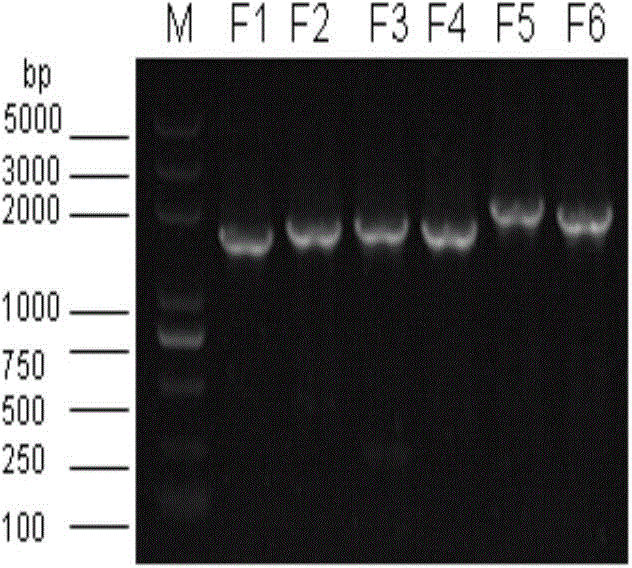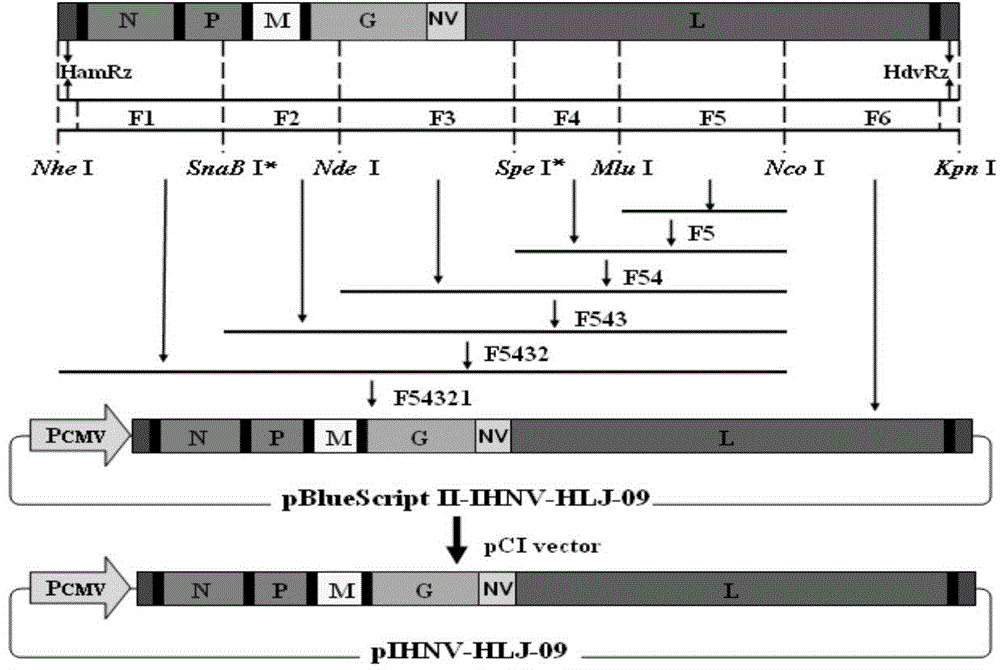Recombination infectious haematopoietic necrosis virus (rIHNV HLJ-09) strain and construction method and application thereof
A hematopoietic organ necrosis, HLJ-09 technology, applied in the biological field, can solve the problems of difficult directional operation and high mutation rate of RNA virus
- Summary
- Abstract
- Description
- Claims
- Application Information
AI Technical Summary
Problems solved by technology
Method used
Image
Examples
Embodiment 1
[0039] Example 1 Obtaining of Recombinant Infectious Hematopoietic Necrosis Virus Strain rIHNV HLJ-09
[0040] Specific steps are as follows:
[0041] 1. Construction of full-length cDNA recombinant plasmid
[0042] Use primer5.0 to analyze the restriction enzyme cutting sites of the whole gene of HLJ-09 strain virus (Genbank accession no. JX649101), select 5 single restriction enzyme cutting sites, and the full-length cDNA is blocked from 5' to 3' direction The internal and introduced enzyme cutting sites SnaB I, Nde I, Spe I, Nhe I, Mlu I, and Nco I are divided into lengths of 1696bp (F1), 1734bp (F2), 1852bp (F3), 1707bp (F4) respectively. ), 6 fragments of 2140bp (F5) and 1997bp (F6) were amplified by RT-PCR, and the two restriction sites of SnaB I and Spe I were nonsense mutations, which were used as molecular markers for the difference between the recombinant virus and the parental virus. The primers and amplified segments required for genome segment amplification are ...
Embodiment 2
[0069] Example 2 Application of rIHNV HLJ-09 strain in virus vector
[0070] Specific steps are as follows:
[0071] 1. Rescue of recombinant virus rIHNV-EGFP
[0072] Using the rIHNV HLJ-09 reverse genetics system, the NV ORF reporter gene of rIHNV HLJ-09 was replaced with the EGFP (green fluorescent protein) coding gene to construct the recombinant plasmid pIHNV-EGFP; The L15 in FBS was reared in a 24-well plate, and the cell density was about 80%-90%. Add 1 μg pIHNV-EGFP and 0.5 μg pCI-N, 0.5 μg pCI-P, 0.2 μg pCI-L, 0.1 μg pCI-NV, 0.1 μg pCI-G plasmids to 200 μL serum-free L15 medium, and mix gently uniform. Add 0.6 μL PLUSTM Reagents to the DNA mixture, mix gently, and incubate at room temperature for 5 minutes. Add 200 μL of the above transfection solution into CHSE-214 cells, and gently shake the 24-well plate back and forth. Place the transfection plate in an incubator at 25°C for 6 hours, discard the liquid, and add freshly prepared L15 culture liquid containing 1...
PUM
 Login to View More
Login to View More Abstract
Description
Claims
Application Information
 Login to View More
Login to View More - R&D
- Intellectual Property
- Life Sciences
- Materials
- Tech Scout
- Unparalleled Data Quality
- Higher Quality Content
- 60% Fewer Hallucinations
Browse by: Latest US Patents, China's latest patents, Technical Efficacy Thesaurus, Application Domain, Technology Topic, Popular Technical Reports.
© 2025 PatSnap. All rights reserved.Legal|Privacy policy|Modern Slavery Act Transparency Statement|Sitemap|About US| Contact US: help@patsnap.com



